 FDR? You mean Franklin Delano Roosevelt, 32d president of the USofA?
FDR? You mean Franklin Delano Roosevelt, 32d president of the USofA?
Not quite. I mean FDR SK8park, in Philadelphia.
“SK8park”? What’s that? Can’t you spell?
Yes I can. Sound it out.
Oh, you mean “skate park”.
Right. SK8park, FDR SK8park. It’s at the southern end of Franklin Delano Park.
What’s this skateboard nation?
It’s a notion, if you will, a conceit, a turn of phrase, a way of speaking. Perhaps, if you will, an identity of sorts. And that’s what this is about.
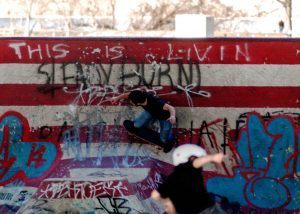
The do-it-yourself “spot” or park is one facet of skateboarding. A bunch of skateboarders will find an out-of-the-way spot and remake it to their purposes, installing rails, half-pipes, banks, pyramids, and other features. Some of these are fairly small, like the one I ran into some years ago in Jersey City when I was photographing graffiti. Others are quite large, like Philly’s FDR, which is one of the largest and best-known DIY parks in the world.
FDR is festooned with graffiti and street art. Most of it is a grab-bag of standard stuff, tags, throw-ups, pieces of varying quality, posters and stickers and what have you. But some of it is of a different nature. That’s what I’m interested in.
As you read this, think of yourself as an explorer, an archeologist perhaps – Indiana Jones? You’ve come across a strange civilization. You’ve talked with a native or two, but mostly you’re examining the markings they’ve made. What do they mean?
Consider the photo at the right (from 2014). Up at the top it says “THIS IS LIVIN’”. Whatever ‘this’ is that, presumably, is what we see these two people doing, skate boarding. And they’re passionate about it.
What about those red and white stripes, though, what are they? Here’s a more recent photo (from 2017) of the same area, though a much wider view:
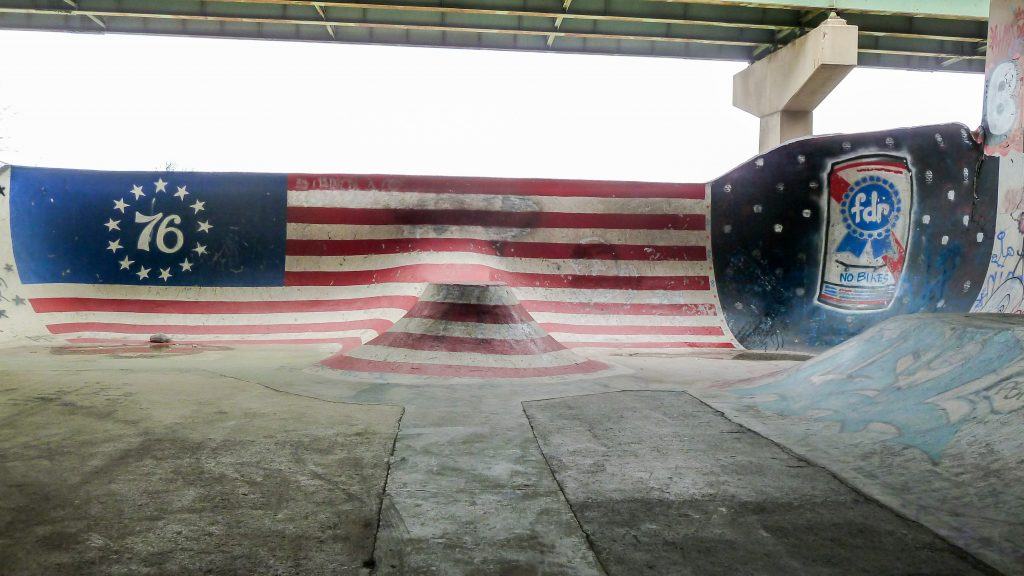
The random markings have been painted over, necessary, I assume, because the skating degrades the painted surface. That’s a version of the American flag, the so-called Betsy Ross version. We’ve got 13 stars in a circle against a field of blue at the upper left and then the standard 13 red and white stripes. The “76” isn’t part of the flag design but was added by the artist, whoever it is. 1776, of course, is the year that American declared it’s independence from Great Britain.
Notice the beer can at the right. What’s that doing here? For one thing the red, white, and blue colors of Pabst Blue Ribbon fit in nicely with the flag colors. Moreover where a real can would proclaim “Pabst Blue Ribbon” we see instead, “fdr”. Pabst Blue Ribbon is often referred to as PBR, which transmutes easily into “fdr”. Beyond this, PBR has some considerable currency in popular culture, though just why that is so, I don’t know (Wikipedia lists a bunch of occurrences in movies, TV, and song).
Still, why a beer can? Most likely it’s symbol of good times, though I’m guessing that mixing PBRs and skateboarding is a bit risky – and may well violate open-container laws as well. But it’s an interesting combination, beer, patriotism, and skateboarding: “THIS IS LIVIN’”
Now look at this photo:

Across the center we see “FDR”, “4th of July 2018”, “FDR Since•96” and the Liberty Bell, all against a familiar background of red, white, and blue. We know what “FDR” stands for. Yes, Franklin Delano Roosevelt, 32nd president of the United States, but more particularly for the skate park itself. For anyone in the skateboarding world “FDR” means this skate park, not the larger park and not the president that park is named after.
The 4th of July is, of course, Independence Day, a national holiday in the United States that commemorates the day the Declaration of Independence was signed in 1776. Where was it signed? In Philadelphia, the home of the Second Continental Congress. The Liberty Bell hung in Independence Hall, formerly the Pennsylvania State House, and is a symbol of American Independence.
And then we have “FDR since•96”. Here’s a bit of history from Transworld SKATEboarding in 2001:
FDR is to Philadelphia as Burnside is to Portland: city-owned, skater-built, and not for the meek. This sacred space beneath Interstate 95 in South Philly has come a long way since its fledgling days in 1994, when it was born as a result of Philadelphia government’s desire to eliminate skateboarding at Love Park. As a peace offering to Philly skateboarders, the city set aside approximately 16,000 square feet of real estate beneath the highway, laid down a blacktop slab, threw in a couple of pyramids and a grind box, and called it a “skatepark.” City Hall thought this was enough to solve the problems caused by skaters at Love Park; nothing further happened for about a year and a half, until the locals got restless. Inspired by Burnside, and tired of waiting on the City, they took matters into their own hands and started building a transition up a support pillar here, a corner bowl there, a mogul or two in between.
Notice that phrase, “sacred space”. We’re archaeologists, remember? We take such phrases seriously.
A year and a half from ‘94 would give us ‘96, in effect the year that the skate boarders took over the park and made it their own, designing and constructing their own features. The park has been growing ever since and remains under construction to this day. Around the edges of the completed section you’ll see mounds of dirt, piles of scrap and not-so-scrap wood and wooden forms for pouring concrete. I don’t know where the money comes from – though at one point the city kicked in $25K – nor do I know anything about the administrative structure of the park. As far as I know there is no legal entity taking responsibility for the park (nothing listed in the Wikipedia entry for example). Somehow it just happens: of the people, by the people, and for the people.
Let’s continue with another paragraph from Transworld SKATEboarding:
The story of FDR Skatepark is much like the story of the United States of America. They both began when a government used unpopulated land in an attempt to move a community of people who needed freedom to express themselves. What followed was not expected by anybody; the colonization of these lands did not happen immediately or as planned. It took time, a lot of work, dedication, dreams, sacrifices, and pain. In an effort to tell the skateboarding world how the colonization of FDR Skatepark happened, the following is a collection of conversations, stories, memories, and feelings from skateboarders who have been there since the beginning, as well as recent immigrants.
And that’s what we in the imagery painted at the park.
In my experience graffiti writers and street artists do not normally employ patriotic imagery, but some of them at FDR do. It is not clear to me just how the story/mythology of this park became infused with the story/mythology of the nation, but that is clearly what has happened. I’m guessing it’s a combination of two things. On the one hand we have FDR’s importance in the world of skateboarding: “We built this, with our own hands, according to our own designs, we the citizens of skateboard nation.” On the other hand we have the fact this park is located in Philadelphia, which plays an im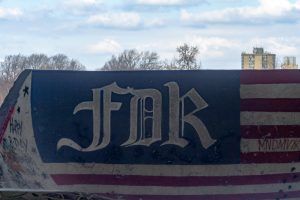 portant role in national mythology and which uses that role in marketing itself as a tourist destination. Some people come to Philadelphia to see Independence Hall and the Liberty Bell. Others come to skate at FDR.
portant role in national mythology and which uses that role in marketing itself as a tourist destination. Some people come to Philadelphia to see Independence Hall and the Liberty Bell. Others come to skate at FDR.
Let’s return to that flag. The upper left, where the stars ordinarily go, has changed since 2017. The 13 stars and “96” have now been replaced by the letters “FDR”, and in ornate blackletter script no less – a ceremonial touch? What does that signify? A further appropriation of American patriotic dress for the skate board nation?
Consider another photo (belwo). The shield is in the form of a keystone, the topmost stone of a masonry arch; but it is also a symbol of Pennsylvania and signifies the state’s importance in the early nation. Placing “FDR” within the keystone has the effect of identifying the state and the skate park with one another thus amplifying FDR’s quasi-civic significance. Notice, in passing, the stickers along the top.
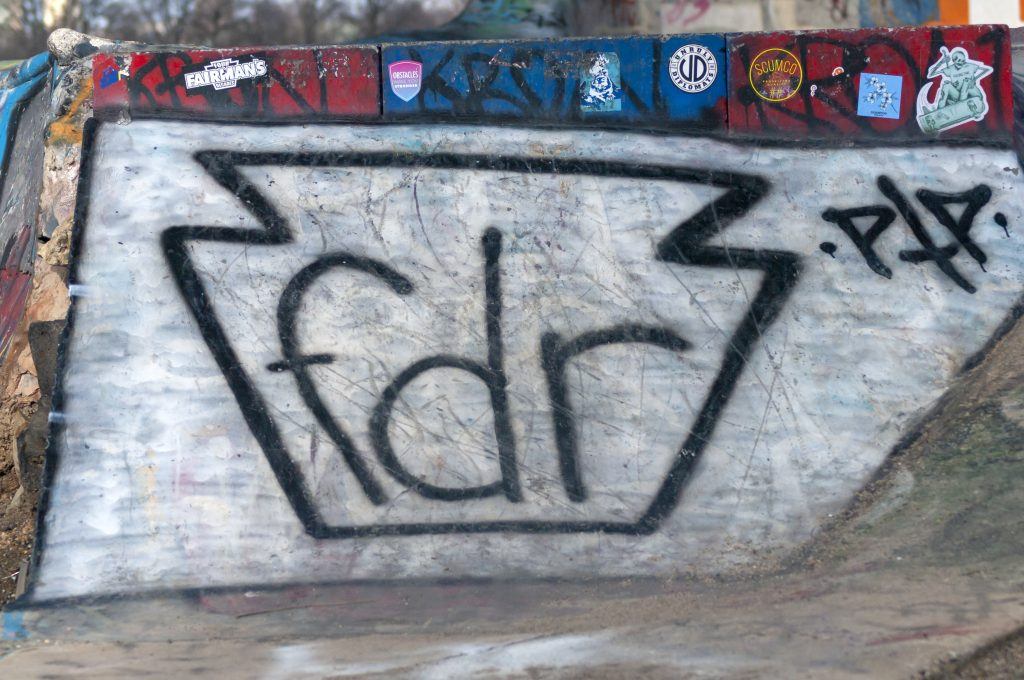
The next photo has two keystones. Look at column at the far left; just below the center there’s a black panel. We’ve got the letters “fdr” (in lower case) enclosed in a keystone shield. Up at the top we have “SOBER VS. WASTED” and at the bottom, “WE HAVE YOU”. In other words, this is home, we are family.
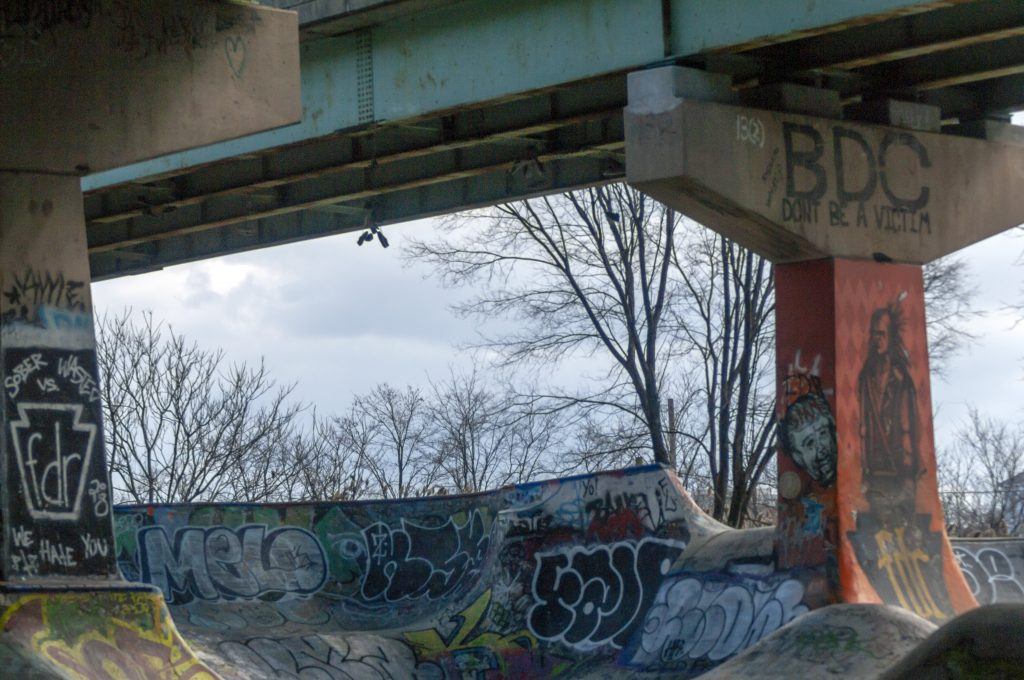
Now look over at the column on the right. There’s an American Indian on the face of that column and he’s standing positioned behind another “fdr” keystone. Here’s a better shot:
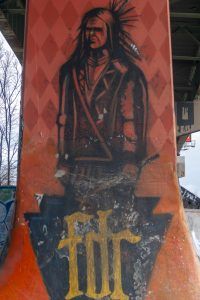
The figure is clearly male and the long hair and feathers indicate that he is a Native American (aka Indian). The jacket almost looks like a double-breasted blazer or sport jacket. Almost. He’s holding something in his left hand. It looks like an arrow, but I can’t really tell. But we can’t be mistaken about the fact that he’s emerging from a keystone on which the letters “fdr” are inscribed in black-letter font. The Indian links the image to the people who inhabited the land prior the colonization.
Here’s another image of a Native American:
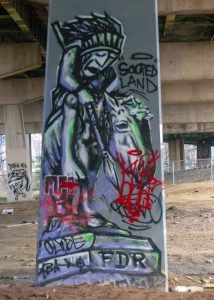
The image shows a statue of an Indian on horseback. It depicts a memorial. To the right of his head it says, beneath what appears to be a halo or perhaps a crown, “SACRED LAND”. Presumably it is FDR itself that is the sacred land – recall that the article in Transworld SKATEboarding called this “sacred space”.
Do these skateboarders, some of them at least, identify with the Indians? For all I know some of the skateboarders may well be Indian – some likely are – but I don’t think that’s what’s going on here. There’s a broader statement, one about being displaced and marginalized and yet, nonetheless, a coherent group, a nation. In this case, it’s a nation grounded in and founded on this land for the purpose of skateboarding.
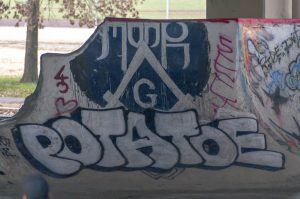
Let’s consider a somewhat different photo (at right). The compass and square at the center of that photo is a symbol of Freemasonry, along with the “G” (for geometry, among other things). I don’t know the (possibly local) significance of the letters at the top, which I read as “MONR”. But Freemasonry is widespread though it started in Medieval guilds of stonemasons. What’s the likelihood that some actual stonemasons have been involved in the construction of FDR? I’d say it’s all but certain. There’s a lot of skill in those walls and features. (As for “POTATOE” it appears to me to have nothing to do with the Masonic symbol.)
This symbol has a somewhat different valence from the flag, the keystone, and the Indian (not to mention the PBR). It’s grounded in a specific craft, one relevant to this site, but also with a rich body of associated symbols.
Let’s consider one last photo:
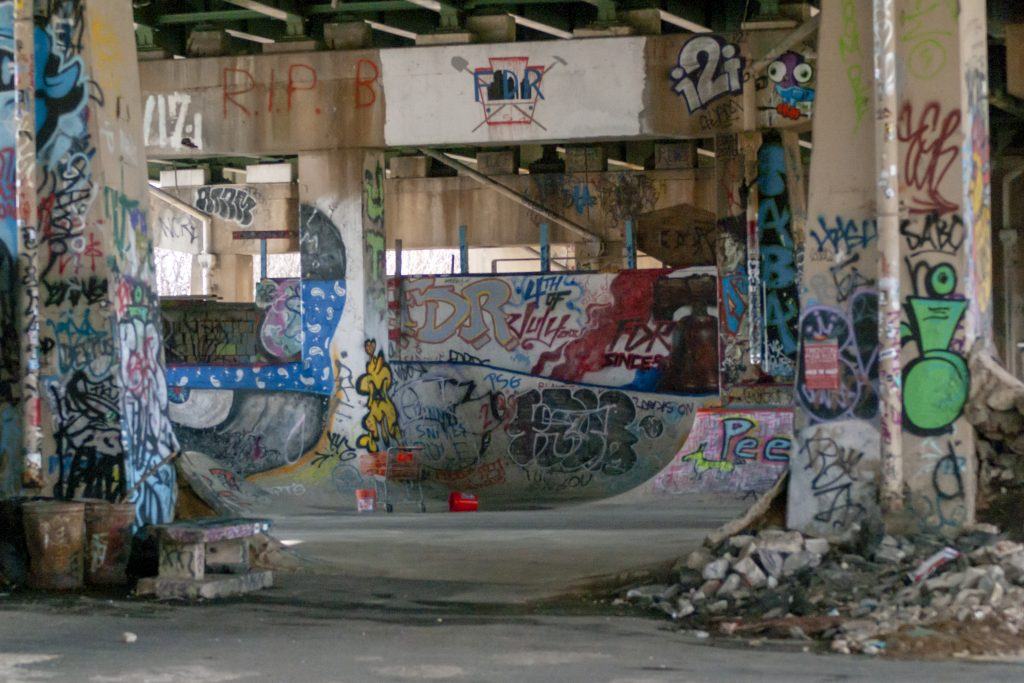
At the center we see that 4th of July panel we’ve discussed above. What’s that up at the top on the white background? Let’s zoom in (below). There’s a red keystone with “FDR” in blue lettering. I suspect that the black markings on the keystone are silhouettes if Philadelphia buildings, though I don’t know the city well enough to identify then. And then, in gray, we have images of a shovel and hoe, tools used in mixing cement. This symbol, then, would seem to be a link between the civic elements represented by the keystone and the red, white, and blue colors of the flag with lineage of Freemasonry.
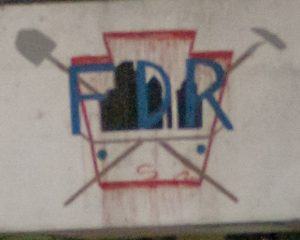
What, then, do we have? While it’s possible that there is a decorating committee that has to approve whatever goes up on the walls here, that seems very unlikely. Paint goes on these walls because various people want it there and it’s allowed to stay there because a loose consensus allows it. This system of symbols we’ve been observing reflects that loose consensus, an evolving understanding of the role of this SK8park in the civic life of the city and of the nation.
Which nation?
Why the skateboard nation of course.
Of course.
